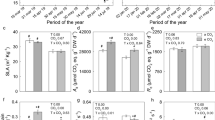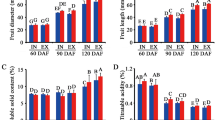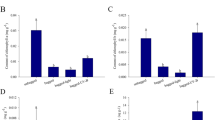Abstract
Appropriate adjustment of various microclimatic and nutrient conditions can improve crop productivity under greenhouse cultivation. Here, we performed non-targeted profiling to investigate metabolite variation in tomato fruits following different supplementary LED lighting (SL) (red: R; blue: B; and a combination of red and blue light: RB, for 1 h/day and 6 h/day per condition) and mineral nutrient supply (N, K, Mg). The different SL treatments affected metabolite variation in tomato fruits more significantly than mineral nutrients. Importantly, regulating the SL period induced a more distinct metabolite composition in tomato fruits than that induced by varying the SL sources. Tomato fruits cultivated under RB for 6 h/day had a relatively higher content of sugar derivatives, especially sucrose, thus influencing the gustatory characteristics of the fruit. In contrast, fruit from tomatoes cultivated under RB for 1 h/day showed a distinctive increase in the abundance of amino acids, organic acids, and several secondary metabolites, adding to its nutritional quality. Intriguingly, the different mineral supplements elicited discriminant metabolic variation in tomato fruits cultivated under reduced levels of mineral supply; however, the effects were insignificant under enhanced levels of mineral supply. Specifically, reduced level in nitrogen supply resulted in a lower abundance of amino acids, whereas reduced level in potassium supply increased metabolite levels including amino acids, sugars, and fatty acids in tomato fruits. In the present study, we employed a non-targeted metabolomics approach to unravel the effects of microclimatic parameters and mineral nutrients on fruit quality parameters of tomato plants, by which regulating the period of SL and reducing the potassium concentration were suggested to improve different nutritional qualities.





Similar content being viewed by others
Data availability
All data generated or analysed during this study are included in this published article and its supplementary information files.
References
Almeselmani M, Pant RC, Singh B (2010) Potassium level and physiological response and fruit quality in hydroponically grown tomato. Int J Veg Sci 16:85–99. https://doi.org/10.1080/19315260903271526
Bénard C, Gautier H, Bourgaud F, Grasselly D, Navez B, Caris-Veyrat C, Génard M (2009) Effects of low nitrogen supply on tomato (Solanum lycopersicum) fruit yield and quality with special emphasis on sugars, acids, ascorbate, carotenoids, and phenolic compounds. J Agric Food Chem 57:4112–4123
Causin HF (1996) The central role of amino acids on nitrogen utilization and plant growth. J Plant Physiol 149:358–362. https://doi.org/10.1016/S0176-1617(96)80134-9
Chen XL, Yang QC (2018) Effects of intermittent light exposure with red and blue light emitting diodes on growth and carbohydrate accumulation of lettuce. Sci Hortic 234:220–226. https://doi.org/10.1016/j.scienta.2018.02.055
Dorai M, Papadopoulos A, Gosselin A (2001) Influence of electric conductivity management on greenhouse tomato yield and fruit quality. Agronomie 21:367–383
Dzakovich MP, Gómez C, Mitchell CA (2015) Tomatoes grown with light-emitting diodes or high-pressure sodium supplemental lights have similar fruit-quality attributes. HortScience 50:1498–1502
Epstein E (1956) Mineral nutrition of plants: mechanisms of uptake and transport. Annu Rev Plant Physiol 7:1–24. https://doi.org/10.1146/annurev.pp.07.060156.000245
Gautier H, Diakou-Verdin V, Bénard C, Reich M, Buret M, Bourgaud F, Génard M (2008) How does tomato quality (sugar, acid, and nutritional quality) vary with ripening stage, temperature, and irradiance? J Agric Food Chem 56:1241–1250
Giliberto L, Perrotta G, Pallara P, Weller JL, Fraser PD, Bramley PM, Giuliano G (2005) Manipulation of the blue light photoreceptor cryptochrome 2 in tomato affects vegetative development, flowering time, and fruit antioxidant content. Plant Physiol 137:199–208. https://doi.org/10.1104/pp.104.051987
Guan HP, Janes HW (1991) Light regulation of sink metabolism in tomato fruit: I. Growth and sugar accumulation. Plant Physiol 96:916–921. https://doi.org/10.1104/pp.96.3.916
Guo W, Nazim H, Liang Z, Yang D (2016) Magnesium deficiency in plants: an urgent problem. Crop J 4:83–91. https://doi.org/10.1016/j.cj.2015.11.003
Hafsi C, Debez A, Abdelly C (2014) Potassium deficiency in plants: effects and signaling cascades. Acta Physiol Plant 36:1055–1070. https://doi.org/10.1007/s11738-014-1491-2
Haque MM, Hasanuzzaman M, Rahman ML (2009) Effect of light intensity on the morpho-physiology and yield of bottle gourd (Lagenaria vulgaris). Acad J Plant Sci 2:158–161
Heo JW, Lee YB, Kim DE, Chang YS, Chun C (2010) Effects of supplementary LED lighting on growth and biochemical parameters in Dieffenbachia amoena ‘Camella’ and Ficus elastica ‘Melany’. Kor J Hortic Sci Technol 28:51–58
Hudina M, Colarič M, Štampar F (2007) Primary metabolites in the leaves and fruits of three pear cultivars during the growing season. Can J Plant Sci 87:327–332. https://doi.org/10.4141/P05-232
Ilić ZS, Milenković L, Stanojević L, Cvetković D, Fallik E (2012) Effects of the modification of light intensity by color shade nets on yield and quality of tomato fruits. Sci Hortic 139:90–95. https://doi.org/10.1016/j.scienta.2012.03.009
Jiang C, Johkan M, Hohjo M, Tsukagoshi S, Ebihara M, Nakaminami A, Maruo T (2017) Photosynthesis, plant growth, and fruit production of single-truss tomato improves with supplemental lighting provided from underneath or within the inner canopy. Sci Hortic 222:221–229. https://doi.org/10.1016/j.scienta.2017.04.026
Jung ES, Lee S, Lim SH, Ha SH, Liu KH, Lee CH (2013) Metabolite profiling of the short-term responses of rice leaves (Oryza sativa cv. Ilmi) cultivated under different LED lights and its correlations with antioxidant activities. Plant Sci 210:61–69. https://doi.org/10.1016/j.plantsci.2013.05.004
Kim YX, Steudle E (2007) Light and turgor affect the water permeability (aquaporins) of parenchyma cells in the midrib of leaves of Zea mays. J Exp Bot 58:4119–4129. https://doi.org/10.1093/jxb/erm270
Kim CH, Seong K-C, Jung YB, Lim CK, Moon DG, Song SY (2016) Establishment of discrimination system using multivariate analysis of FT-IR spectroscopy data from different species of artichoke (Cynara cardunculus var. scolymus L.). Kor J Hortic Sci Technol 34:324–330. https://doi.org/10.12972/kjhst.20160033
Kim YX, Kim TJ, Lee Y, Lee S, Lee D, Oh T-K, Sung J (2018) Metabolite profiling and mineral nutrient analysis from the leaves and roots of bell pepper (Capsicum annuum L. var. angulosum) grown under macronutrient mineral deficiency. Appl Biol Chem 61:661–671. https://doi.org/10.1007/s13765-018-0395-z
Lemoine R, La Camera S, Atanassova R, Dédaldéchamp F, Allario T, Pourtau N, Bonnemain JL, Laloi M, Coutos-Thévenot P, Maurousset L, Faucher M, Girousse C, Lemonnier P, Parrilla J, Durand M (2013) Source-to-sink transport of sugar and regulation by environmental factors. Front Plant Sci 4:272. https://doi.org/10.3389/fpls.2013.00272
Li Y, Wang H, Zhang Y, Martin C (2018) Can the world’s favorite fruit, tomato, provide an effective biosynthetic chassis for high-value metabolites? Plant Cell Rep 37:1443–1450. https://doi.org/10.1007/s00299-018-2283-8
Lu N, Maruo T, Johkan M, Hohojo M, Tsukagoshi S, Ito Y, Shinohara Y (2012) Effects of supplemental lighting within the canopy at different developing stages on tomato yield and quality of single-truss tomato plants grown at high density. Environ Control Biol 50:1–11. https://doi.org/10.2525/ecb.50.1
Manivannan A, Soundararajan P, Halimah N, Ko CH, Jeong BR (2015) Blue LED light enhances growth, phytochemical contents, and antioxidant enzyme activities of Rehmannia glutinosa cultured in vitro. Hortic Environ Biotechnol 56:105–113. https://doi.org/10.1007/s13580-015-0114-1
Manivannan A, Soundararajan P, Park YG, Wei H, Kim SH, Jeong BR (2017) Blue and red light-emitting diodes improve the growth and physiology of in vitro-grown carnations ‘Green Beauty’ and ‘Purple Beauty’. Hortic Environ Biotechnol 58:12–20. https://doi.org/10.1007/s13580-017-0051-2
Neugart S, Krumbein A, Zrenner R (2016) Influence of light and temperature on gene expression leading to accumulation of specific flavonol glycosides and hydroxycinnamic acid derivatives in Kale (Brassica oleracea var. sabellica). Front Plant Sci 7:326. https://doi.org/10.3389/fpls.2016.00326
Scheible WR, Morcuende R, Czechowski T, Fritz C, Osuna D, Palacios-Rojas N, Stitt M (2004) Genome-wide reprogramming of primary and secondary metabolism, protein synthesis, cellular growth processes, and the regulatory infrastructure of Arabidopsis in response to nitrogen. Plant Physiol 136:2483–2499. https://doi.org/10.1104/pp.104.047019
Snider JL, Russo VM, Roberts W, Wann EV, Raper RL (2012) Cultural and environmental factors governing tomato production: local production under elevated temperatures. HortScience 47:1022–1028
Son SY, Kim NK, Lee S, Singh D, Kim GR, Lee JS, Lee CH (2016) Metabolite fingerprinting, pathway analyses, and bioactivity correlations for plant species belonging to the Cornaceae, Fabaceae, and Rosaceae families. Plant Cell Rep 35:1917–1931. https://doi.org/10.1007/s00299-016-2006-y
Son K-H, Lee S-R, Oh M-M (2018) Comparison of lettuce growth under continuous and pulsed irradiation using light-emitting diodes. Hortic Sci Technol 36:542–551. https://doi.org/10.12972/kjhst.20180054
Steinger T, Roy BA, Stanton ML (2003) Evolution in stressful environments II: adaptive value and costs of plasticity in response to low light in Sinapis arvensis. J Evol Biol 16:313–323
Sung J, Lee S, Lee Y, Ha S, Song B, Kim T, Krishnan HB (2015) Metabolomic profiling from leaves and roots of tomato (Solanum lycopersicum L.) plants grown under nitrogen, phosphorus or potassium-deficient condition. Plant Sci 241:55–64. https://doi.org/10.1046/j.1420-9101.2003.00518.x
Sung J, Yun H, Back S et al (2018) Changes in mineral nutrient concentrations and C–N metabolism in cabbage shoots and roots following macronutrient deficiency. J Plant Nutr Soil Sc 181:777–786. https://doi.org/10.1002/jpln.201800001
Takahashi H, Imamura T, Miyagi A, Uchimiya H (2012) Comparative metabolomics of developmental alterations caused by mineral deficiency during in vitro culture of Gentiana triflora. Metabolomics 8:154–163. https://doi.org/10.1007/s11306-011-0295-2
Trouwborst G, Oosterkamp J, Hogewoning SW, Harbinson J, Van Ieperen W (2010) The responses of light interception, photosynthesis and fruit yield of cucumber to LED-lighting within the canopy. Physiol Plant 138:289–300. https://doi.org/10.1111/j.1399-3054.2009.01333.x
White PJ, Karley AJ (2010) Potassium. In: Hell R, Mendel R-R (eds) Cell biology of metals and nutrients. Springer, Heidelberg, pp 199–224
Wojciechowska R, Długosz-Grochowska O, Kołton A, Żupnik M (2015) Effects of LED supplemental lighting on yield and some quality parameters of lamb’s lettuce grown in two winter cycles. Sci Hortic 187:80–86. https://doi.org/10.1016/j.scienta.2015.03.006
Zoratti L, Karppinen K, Luengo Escobar A, Häggman H, Jaakola L (2014) Light-controlled flavonoid biosynthesis in fruits. Front Plant Sci 5:534. https://doi.org/10.3389/fpls.2014.00534
Zotarelli L, Scholberg JM, Dukes MD, Muñoz-Carpena R, Icerman J (2009) Tomato yield, biomass accumulation, root distribution and irrigation water use efficiency on a sandy soil, as affected by nitrogen rate and irrigation scheduling. Agric Water Manag 96:23–24. https://doi.org/10.1016/j.agwat.2008.06.007
Acknowledgements
This research was funded by the “Cooperative Research Program for Agriculture Science & Technology Development (Project No. PJ012523)” and by 2019 RDA Fellowship Program of Rural Development Administration, Republic of Korea.
Author information
Authors and Affiliations
Contributions
JS, YL, DL, and SL conceived the idea and designed the study. YXK and SL performed experiments of cultivating tomato plants and measuring physiological parameters. HJG performed metabolomics experiments. ESJ and CHL participated in the discussions of metabolomics data. YXK, JS, YL, DL, and SL participated in the discussion. HJG, YXK, JS, ESJ, DS, and SL prepared the manuscript.
Corresponding author
Ethics declarations
Conflict of interest
The authors declare no conflict of interest.
Additional information
Communicated by Young Yeol Cho, Ph.D.
Publisher's Note
Springer Nature remains neutral with regard to jurisdictional claims in published maps and institutional affiliations.
Electronic supplementary material
Below is the link to the electronic supplementary material.
Rights and permissions
About this article
Cite this article
Gil, H.J., Kim, Y.X., Sung, J. et al. Metabolomic insights of the tomato fruits (Solanum lycopersicum L.) cultivated under different supplemental LED lighting and mineral nutrient conditions. Hortic. Environ. Biotechnol. 61, 415–427 (2020). https://doi.org/10.1007/s13580-019-00215-8
Received:
Revised:
Accepted:
Published:
Issue Date:
DOI: https://doi.org/10.1007/s13580-019-00215-8




